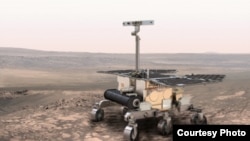PARIS —
The European Space Agency signed final contracts with Thales Alenia Space Italy for work on a pair of missions to assess if the planet Mars has or ever had life, officials said at the Paris Airshow this week.
Until last year, the ExoMars program was a joint project between ESA and the U.S. space agency NASA. But NASA dropped out, citing budget problems.
The Russian space agency Roscosmos stepped in to provide two Proton rockets to send an orbiting atmospheric probe and test lander to Mars in January 2016, and a follow-on rover in August 2018 that will drill below the planet's surface to look for spores and bacteria.
Roscosmos also is providing a landing system for the rover and scientific instruments.
“It took some time, some energy, some efforts from a lot of different parties. It was not easy to move from an ESA-NASA cooperation to an ESA-Roscosmos cooperation,” Jean-Jacques Dordain, head of ESA, told reporters after signing a 230 million euros [$300 million] contract with Thales Alenia.
Thales Alenia, selected as the ExoMars prime contractor five years ago, plans to spend 146 million euros on the 2016 orbiter and lander. The satellite is being designed to search the thin Martian atmosphere for telltale gasses associated with biological activity. It also will serve as the key communications relay for the 2018 rover.
The lander primarily is intended to test the technologies needed to touch down on Mars, a notoriously difficult task that has bedeviled nearly all of Russia's previous efforts and has given NASA trouble as well. The United States currently has two operational rovers on Mars, Curiosity and Opportunity.
After pulling out of the ExoMars program, NASA said it would send a second Curiosity-type rover to Mars in 2020.
The rest of the ExoMars budget will be spent on the 2018 rover, a mission that will make the first direct search for life since NASA's 1970s-era Viking landers.
Instead of sampling the planet's radiation-blasted surface as the Viking probes did, the ExoMars rover will use a radar sounder to search for subterranean water and then drill down about six feet (two meters) for samples that will be processed through onboard laboratories.
“If there is any life and if we discover it, it will be unambiguous,” said Vincenzo Giorgo, Thales Alenia's vice president of exploration and space. “On Viking everybody thought, 'We found it, we found it,' but then nobody could prove it.”
Thales Alenia Space is a joint venture owned 67 percent by France's Thales and 33 percent by Italy's Finmeccanica .
Until last year, the ExoMars program was a joint project between ESA and the U.S. space agency NASA. But NASA dropped out, citing budget problems.
The Russian space agency Roscosmos stepped in to provide two Proton rockets to send an orbiting atmospheric probe and test lander to Mars in January 2016, and a follow-on rover in August 2018 that will drill below the planet's surface to look for spores and bacteria.
Roscosmos also is providing a landing system for the rover and scientific instruments.
“It took some time, some energy, some efforts from a lot of different parties. It was not easy to move from an ESA-NASA cooperation to an ESA-Roscosmos cooperation,” Jean-Jacques Dordain, head of ESA, told reporters after signing a 230 million euros [$300 million] contract with Thales Alenia.
Thales Alenia, selected as the ExoMars prime contractor five years ago, plans to spend 146 million euros on the 2016 orbiter and lander. The satellite is being designed to search the thin Martian atmosphere for telltale gasses associated with biological activity. It also will serve as the key communications relay for the 2018 rover.
The lander primarily is intended to test the technologies needed to touch down on Mars, a notoriously difficult task that has bedeviled nearly all of Russia's previous efforts and has given NASA trouble as well. The United States currently has two operational rovers on Mars, Curiosity and Opportunity.
After pulling out of the ExoMars program, NASA said it would send a second Curiosity-type rover to Mars in 2020.
The rest of the ExoMars budget will be spent on the 2018 rover, a mission that will make the first direct search for life since NASA's 1970s-era Viking landers.
Instead of sampling the planet's radiation-blasted surface as the Viking probes did, the ExoMars rover will use a radar sounder to search for subterranean water and then drill down about six feet (two meters) for samples that will be processed through onboard laboratories.
“If there is any life and if we discover it, it will be unambiguous,” said Vincenzo Giorgo, Thales Alenia's vice president of exploration and space. “On Viking everybody thought, 'We found it, we found it,' but then nobody could prove it.”
Thales Alenia Space is a joint venture owned 67 percent by France's Thales and 33 percent by Italy's Finmeccanica .










